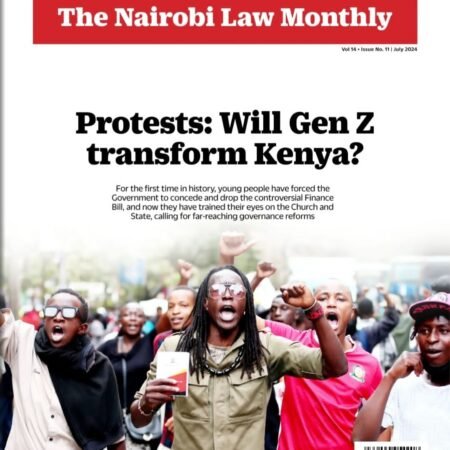By Thomas Vinod
The COVID-19 experience illustrates the failure of markets in preventing pandemics and the potential of public expenditures on a global scale to eventually spur a response. In a similar vein, the world’s top carbon emitters, China, the United States, India, Russia, and Japan—responsible for a combined 60 percent of global effluents —have done little to avert a climate catastrophe, and they must now lead a global fiscal stimulus to tackle the problem. A big difference from the COVID-19 experience: Climate spending is not just to put money in people’s pockets, but to promote low-carbon economic growth.
-
Sale!
Download Nairobi Law Monthly Magazine July 2024 Edition
Downloads Original price was: KShs200.00.KShs100.00Current price is: KShs100.00.
The invisible hand, if not a guiding hand, of the government usually suffices to avert problems in well-functioning markets. But with the extreme failure of markets and massive spillover of damages from economic activities causing global warming, solutions call for a stronger hand of government, much as in the case of COVID-19.
The economic rationale for a well-implemented climate stimulus is fourfold:
This is a time to build on the cleaner air that the pandemic has left. In the wake of COVID-19, cities around the world have seen sharp improvements in air quality. In the month after the March 25 lockdown, Delhi’s particulate pollution, emanating from vehicles, factories, and construction, fell by 60 percent. Nitrogen dioxide, linked to vehicles, fell sharply in Wuhan, China during February following the transport shutdown. But carbon dioxide, the chief culprit in global warming, was a record 416.2 parts per million in April 2020 because of past accumulation.
Global climate action does not have to come at the expense of sustained economic growth. In fact, lack of action most certainly will block growth. A climate stimulus will not add to the economic turmoil from COVID-19 because decarbonization does not call for curtailing economic activity. Rather, the way forward is to reduce carbon intensive-energy—renewables are now a competitive alternative—and to expand pollution-control technologies, all at a fraction of the cost of limiting economic activity.
The clearest trade-off to be made in spending would be eliminating the subsidies for fossil fuels, which get nearly $5.2 trillion. On the other hand, there is a justification on social welfare grounds for incentives to be given for renewable energy.
Climate mitigation is an investment to avoid massive damages and sustain economic growth. The benefits of implementing the Paris Agreement on climate change far outweigh its costs. The capital investment required to replace fossil fuels by renewables to keep global temperature rise below the dangerous threshold of 1.5 degrees centigrade is $2.4 trillion a year through 2035. By one estimate, averted global indemnities could be $150 trillion to $792 trillion by 2100, or upwards of four times the investment. Health benefits alone could exceed investment costs 1.5-2.5 times.
Some are already seeing COVID-19’s stimulus packages as an opportunity to spur green growth. The United Kingdom plans to spend 250 million pounds of its stimulus package on walking and cycling infrastructure. Ten European Union nations have called for using recovery packages to support the European Green Deal for climate neutrality by 2050. As part of a green recovery, Tasmania has targeted 200 percent clean energy, including energy exports, by 2040. C40 Cities, a network of 96 cities—representing one-quarter of the global economy—have pledged environmental sustainability in COVID-19 recovery.
While the case for climate action now is loud and clear, the challenge remains intimidating. For global temperatures not to exceed 1.5 degrees centigrade, carbon emissions need to be cut by 7.6 percent yearly, which would bring down emissions in carbon equivalent to 25 gigatons by 2030. This would be sharply different from the current trends, which in the best case of following the current pledges shows a level well above 25 gigatons in 2030 and temperatures accordingly headed well above the 1.5 degrees centigrade threshold.
So, to make a difference, sizable resources need to be committed for low-carbon activities, even at the expense of less critical objectives. In principal, this would seem doable with the perspective of the COVID-19 action. Compared to the $2.4 trillion per year cost of carbon transition, the group of the largest 20 economies committed $5 trillion in 2020 for the pandemic stimulus packages.
The clearest trade-off to be made in spending would be eliminating the subsidies for fossil fuels. Globally, coal, oil, and gas get nearly $400 billion yearly in subsidies, which balloons, by one estimate, to $5.2 trillion (in 2017) in total costs when the environmental and health damages are accounted for. On the other hand, there is a justification on social welfare grounds for incentives to be given for renewable energy.
The biggest carbon emitters, like the United States and India, are also at the high end of countries most damaged by climate impacts. Therefore, the socioeconomic rationale for them to lead a fiscal action plan to transition to low-carbon growth is clear. What’s needed is for the leadership in these countries to muster the political will to choose a low-carbon growth path.


